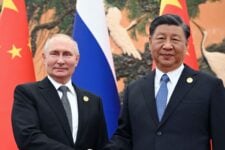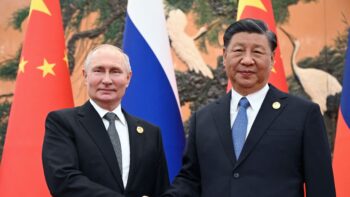
Virginia-class fast-attack submarine USS South Dakota (SSN 790) transits the Thames River during a homecoming event at Naval Submarine Base New London, Conn. (US Navy)
WASHINGTON — It’s “exciting” that Congress may exempt Australia from US restrictions on sharing sensitive technologies, Australia’s Chief Defense Scientist said today. But, Tanya Munro warned, legislative reforms won’t mean much if they’re not followed by a cultural shift in the bureaucracy as well.
“The prospect of significant legislative change is really exciting,” Munro told Breaking Defense after her remarks to the Center for a New American Security, “[but] it’ll have to be a culture change program as well.”
“I think the legislation will open the door to cultural change, but I’m not naïve, and I believe cultural change will take some time,” she added.
There’s been no lack of high-level enthusiasm in Canberra, London, and Washington for greater cooperation on defense, embodied in the trilateral AUKUS pact between Australia, United Kingdom and the United States announced in 2021. While the best publicized — and most controversial — aspect of AUKUS is specific to nuclear-powered submarines, what’s known as “Pillar 2” calls for broad cooperation on research, development, and fielding of a wide range of “advanced capabilities,” from AI to cyber to quantum computing.
But there are numerous devils in the details for both parts of AUKUS. Many of them arise from the International Traffic in Arms Regulations (ITAR), which governs exactly what kind of tech the US can legally share with foreign nations, even friendly ones. Some American lawmakers have voiced their support for amending ITAR or creating a carveout for AUKUS participants. But turning top officials’ good intentions into reality often runs aground on the ingrained risk-aversion of middle management in both government and industry, who can face up to 20 years in prison for violating ITAR.
“Senior intent is not enough,” Munro told the CNAS audience. “I’ve had up close and personal experience, where leaders responsible for certain areas of technology have given direction that certain fields of endeavor are not to be NOFORN [Not for Release To Foreign Nationals] — that Australia, for example, is to be brought in because we have something to offer that will help accelerate what the US is doing. And yet, it still gets strangled and frozen, because of the very rational human fears of people within the system that they will be personally liable and accountable for those decisions that go against the precedent and culture.”
“It’s perfectly rational human behavior for people to slap a NOFORN on everything and keep it close, because that’s what they’ve been trained to do,” she told Breaking Defense.
How can the US change such deeply ingrained habits? By focusing leadership energy on pushing through a few high-potential projects, Munro said, using them as “pipe cleaners” to clear clogged bureaucratic stovepipes.
“I believe in driving culture change through specific ‘pipe cleaners’ and programs,” she told Breaking Defense. “We can illustrate what the new legislation allows, in terms of a [new] way of working. It’s up to leaders at every layer through defense and through industry to show what’s expected, what’s allowed, and what’s safe.”
Munro said she would encourage a “really mature conversation about the advantage to the US from this ITAR reform [and] the advantage to the US in having a more broad base of [innovation], the advantage of having more resilience in supply chains and sustainment opportunities.”
But general exhortations are not enough. “If you look at the nuclear powered submarines, I think it’s remarkable how far that cooperative work has come in this short time,” she told Breaking Defense. “I think that’s because it’s tangible. It’s clear how it matters to all three nations, and it’s clear how it drives outcomes for all three nations.”
So are there any other specific projects that might make good forcing functions for reform? “There are — and I’m hoping some of them may be announced before too long,” she said. That’s a reference to a recent declaration by Heidi Shyu, the Pentagon’s often outspoken chief of R&D, that the US will make a major announcement this fall advancing AUKUS cooperation on not just one technology, but “a portfolio of capabilities” related to Pillar 2.
“We can take the intent that is so clearly there at senior ranks of the DoD and through the reform, drive that into the system,” Munro told CNAS. “What gives me heart… is the long history of our men and women in uniform working alongside each other, with trust. That’s what we aspire to bring to our whole ecosystem.”






















